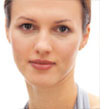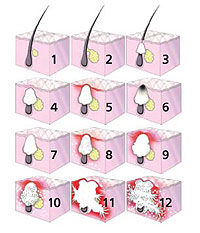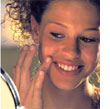|
 |
|
|
|
|
What Exactly Is Acne?
 Acne is one of the most common of all skin problems. Studies show that 80% of all teens get acne, as well as 20% of adults in their twenties to forties, most commonly women. In fact, over 70 million American teens and adults suffer from this embarrassing and frustrating problem, a problem that can cause stress and lower self-esteem. Acne is one of the most common of all skin problems. Studies show that 80% of all teens get acne, as well as 20% of adults in their twenties to forties, most commonly women. In fact, over 70 million American teens and adults suffer from this embarrassing and frustrating problem, a problem that can cause stress and lower self-esteem.
Resulting from the action of hormones on the skin’s oil glands, acne is a skin disorder which leads to plugged pores and the formation of blackheads, white heads, pimples and, in some cases, cysts. Acne most commonly occurs on the face but can also appear on the back, chest, shoulders and neck. Although not life threatening, acne can be extremely upsetting and disfiguring. Left untreated, it can also lead to serious and permanent scarring.
 1. Pre-adolescent hair follicle and sebaceous gland. Note small size of gland. 1. Pre-adolescent hair follicle and sebaceous gland. Note small size of gland.
2. Normal follicle and adolescent sebaceous gland. Note larger sizes of the more active oil gland.
3. Representing the microcomedo - how all acne starts. This microcomedo cannot be seen or felt at this stage.
4-5. The enlarging microcomedo now becomes a closed comedone or white head.
6. The top of the white head opens and an open comedone or black head forms.
7-8-9. Bacteria (represented as black dots) grow and multiply in the plugged follicle, they release substances that attract white blood cells (represented as white dots) the white blood cells release compounds that induces inflammation as illustrated by red shading. This is a papule or red bump.
10-11. Bacteria continue to multiply and grow, more white blood cells are attracted to the follicle, more inflammation this is a pustule, an enlarging red bump with a white center, the classic pimple.
12. The wall of the follicle ruptures, a larger lesion occurs, this would be considered a large very inflamed pimple on its way to becoming a cyst or nodule.
Clear Answers To Important Questions.
 Q: My acne looks different from my friend’s. We both have pimples but his face is much worse than mine. Do we have different conditions? Q: My acne looks different from my friend’s. We both have pimples but his face is much worse than mine. Do we have different conditions?
A: Common acne can be very mild or it can be quite severe. Mild acne generally appears as blackheads and whiteheads and can affect the face, back and chest. As the severity of acne increases, papules “red bumps” and pustules “white centered bumps” appear. In very severe acne there will be many pustules and papules as well as nodules.
Q: How do I know if the Clear Factor System will work for me?
A: The Clear Factor System has been shown to be an effective treatment for acne. Based on Dr. Schiff’s experience, many patients with mild to moderate acne will see significant improvement in their skin. Some results are visible in as little as two weeks; however, a four- to eight-week period may be necessary to obtain optimal results.
 Q: Is Clear Factor tested on animals? Q: Is Clear Factor tested on animals?
A: No, Clear Factor products have never been tested on animals.
Q: Is the Clear Factor System safe to use during pregnancy?
A: It is important to consult your health care provider before using any medication either topical or oral during pregnancy.
 Q: Can the Clear Factor System be used on areas other than the face? Q: Can the Clear Factor System be used on areas other than the face?
A: Yes, Clear Factor is designed to use on any acne prone area including the chest, back and buttocks.
Q: Can makeup be used when using the Clear Factor System?
A: Yes. However, it is best to use an oil free, non-comedogenic makeup. Of course, you should completely remove all makeup before sleeping or exercising.
 Q: What if I develop some redness or irritation while using the Clear Factor System? Q: What if I develop some redness or irritation while using the Clear Factor System?
A: A very small number of patients, most with very sensitive skin, may develop some slight irritation or redness when first using the Clear Factor System. These individuals may be sensitive to Benzoyl Peroxide, the active ingredient in the Correcting Lotion. If this happens, you should discontinue use of the Correcting Lotion for a few days and restart it once every other day. This often allows you to build a tolerance for Benzoyl Peroxide. Gradually you can increase your use to once or twice daily. If irritation persists, you should stop use and see your doctor.
Q: I know that cigarette smoking is bad for your health, but does it cause acne?
A: Cigarette smoking does indeed have adverse effects on the skin over a period of years. Chemicals that are absorbed into the body from cigarette smoke may cause damage to the connective tissue that underlie and supports the skin. This damage may deform the connective tissue and allow a wrinkle to form prematurely. Many long-term cigarette smokers can be identified by their prematurely damaged skin. To the best of our knowledge, tobacco smoking has no known effect on causing acne. However, it will most certainly contribute to the deterioration in your skin’s overall appearance. A smoker should seriously consider stopping as part of an overall program of skin improvement.
|
|
|
|
|
|
|
|
|